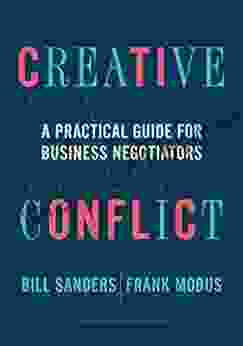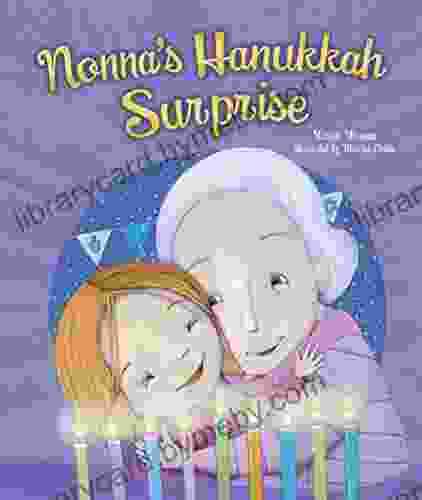Creative Conflict: A Practical Guide for Business Negotiators

Conflict is a natural part of human interaction. It's not something to be feared or avoided, but rather an opportunity for growth and learning. In the business world, conflict can be particularly challenging, but it can also be a powerful tool for driving innovation, building stronger relationships, and achieving better outcomes.
4.1 out of 5
| Language | : | English |
| File size | : | 1729 KB |
| Text-to-Speech | : | Enabled |
| Screen Reader | : | Supported |
| Enhanced typesetting | : | Enabled |
| Word Wise | : | Enabled |
| Print length | : | 240 pages |
If you're a business negotiator, it's essential to have the skills and knowledge to manage conflict effectively. This practical guide will provide you with everything you need to know to get started.
Chapter 1: Understanding Conflict
What is conflict?
Conflict is a disagreement between two or more people. It can be about anything, from a minor issue to a major disagreement. Conflict can be positive or negative, depending on how it is managed.
The benefits of conflict
When managed effectively, conflict can have a number of benefits for businesses, including:
- Increased innovation
- Improved decision-making
- Stronger relationships
- Better outcomes
The five stages of conflict
According to Thomas and Kilmann's Conflict Mode Instrument, there are five stages of conflict:
- Latent conflict: This is the stage where the conflict is hidden or unspoken.
- Perceived conflict: This is the stage where the conflict becomes visible and the parties involved become aware of it.
- Felt conflict: This is the stage where the conflict becomes emotional and the parties involved begin to feel negative emotions towards each other.
- Manifest conflict: This is the stage where the conflict erupts and the parties involved engage in open conflict.
- Conflict aftermath: This is the stage where the conflict is resolved and the parties involved move on.
Chapter 2: Managing Conflict
How to identify conflict
The first step to managing conflict is to identify it. Here are some signs that you may be dealing with conflict:
- Disagreements over goals or objectives
- Tension or hostility between parties
- Poor communication
- Unresolved issues
How to deal with conflict
Once you've identified conflict, it's important to deal with it in a healthy and productive way. Here are some tips:
- Stay calm and objective. It's important to stay calm and objective when dealing with conflict. Avoid getting emotional or defensive.
- Listen to the other person's perspective. It's important to listen to the other person's perspective and try to understand their point of view.
- Be willing to compromise. In most cases, it's impossible to get exactly what you want. Be willing to compromise and find a solution that works for both parties.
- Don't be afraid to seek help. If you're struggling to manage conflict on your own, don't be afraid to seek help from a mediator or counselor.
Chapter 3: Negotiation Skills
The importance of negotiation skills
Negotiation skills are essential for business negotiators. Negotiation is the process of reaching an agreement between two or more parties. By developing strong negotiation skills, you can increase your chances of getting what you want out of a negotiation.
The seven steps of negotiation
According to Roger Fisher and William Ury's book, "Getting to Yes," there are seven steps to negotiation:
- Prepare for negotiation. This involves gathering information, setting your goals, and developing a strategy.
- Build rapport with the other party. This involves getting to know the other party and building a relationship of trust.
- Identify the other party's interests. This involves understanding what the other party wants out of the negotiation.
- State your own interests. This involves clearly stating what you want out of the negotiation.
- Generate options for mutual gain. This involves brainstorming solutions that meet the needs of both parties.
- Negotiate an agreement. This involves reaching an agreement that both parties are happy with.
- Build a strong relationship. This involves maintaining a positive relationship with the other party after the negotiation.
Conflict is a natural part of human interaction. It's not something to be feared or avoided, but rather an opportunity for growth and learning. By developing the skills and knowledge to manage conflict effectively, you can improve your ability to negotiate and achieve better outcomes in business.
This practical guide has provided you with everything you need to know to get started. By following the tips and advice in this guide, you can learn how to harness the power of conflict to drive innovation, build stronger relationships, and achieve better outcomes in business negotiations.
4.1 out of 5
| Language | : | English |
| File size | : | 1729 KB |
| Text-to-Speech | : | Enabled |
| Screen Reader | : | Supported |
| Enhanced typesetting | : | Enabled |
| Word Wise | : | Enabled |
| Print length | : | 240 pages |
Do you want to contribute by writing guest posts on this blog?
Please contact us and send us a resume of previous articles that you have written.
 Book
Book Novel
Novel Page
Page Chapter
Chapter Text
Text Story
Story Genre
Genre Reader
Reader Library
Library Paperback
Paperback E-book
E-book Magazine
Magazine Newspaper
Newspaper Paragraph
Paragraph Sentence
Sentence Bookmark
Bookmark Shelf
Shelf Glossary
Glossary Bibliography
Bibliography Foreword
Foreword Preface
Preface Synopsis
Synopsis Annotation
Annotation Footnote
Footnote Manuscript
Manuscript Scroll
Scroll Codex
Codex Tome
Tome Bestseller
Bestseller Classics
Classics Library card
Library card Narrative
Narrative Biography
Biography Autobiography
Autobiography Memoir
Memoir Reference
Reference Encyclopedia
Encyclopedia Dustin Vaughn Warncke
Dustin Vaughn Warncke Joseph P Weir
Joseph P Weir Michael Cho
Michael Cho Denise B Dailey
Denise B Dailey Gillian Flynn
Gillian Flynn Ben Egginton
Ben Egginton Ben Lamorte
Ben Lamorte Michael J Decker
Michael J Decker Bob Kaufman
Bob Kaufman Ben Smith
Ben Smith Jeff Carreira
Jeff Carreira Glenn N Saxe
Glenn N Saxe Linda S Jones
Linda S Jones Kenneth S Shultz
Kenneth S Shultz Bill Snyder
Bill Snyder Bill Martin Jr
Bill Martin Jr Jill Greenwood
Jill Greenwood Sam Jarman
Sam Jarman Beth Jacobs Phd
Beth Jacobs Phd Blake D Bauer
Blake D Bauer
Light bulbAdvertise smarter! Our strategic ad space ensures maximum exposure. Reserve your spot today!

 Floyd RichardsonWe Are Proud To Present Presentation About The Herero Of Namibia Formerly...
Floyd RichardsonWe Are Proud To Present Presentation About The Herero Of Namibia Formerly...
 Chandler WardUnlock Hormone Harmony: The Comprehensive Guide to Mastering Your Menstrual...
Chandler WardUnlock Hormone Harmony: The Comprehensive Guide to Mastering Your Menstrual... Eric NelsonFollow ·5.2k
Eric NelsonFollow ·5.2k Albert CamusFollow ·13.6k
Albert CamusFollow ·13.6k Bruce SnyderFollow ·18.6k
Bruce SnyderFollow ·18.6k Troy SimmonsFollow ·13.5k
Troy SimmonsFollow ·13.5k Branson CarterFollow ·13.2k
Branson CarterFollow ·13.2k Gus HayesFollow ·9k
Gus HayesFollow ·9k Mike HayesFollow ·16.5k
Mike HayesFollow ·16.5k Keith CoxFollow ·13.1k
Keith CoxFollow ·13.1k

 Ivan Cox
Ivan CoxSpeak With Ease: The Ultimate Guide to Public Speaking...
By Rupika Raj ...

 Jesus Mitchell
Jesus MitchellVulcan Forge: A Suspense Thriller that Will Keep You on...
Vulcan Forge is...

 Dashawn Hayes
Dashawn HayesThe Carteret Family Bob Martin: A Comprehensive Review
Bob Martin's...

 Owen Simmons
Owen SimmonsUnlock the World of Cultural Nuances with "The Global...
Embark on a Journey of...

 Ian McEwan
Ian McEwanConquer the Mountain: True Account of Catastrophe and...
In the heart of California's stunning...
4.1 out of 5
| Language | : | English |
| File size | : | 1729 KB |
| Text-to-Speech | : | Enabled |
| Screen Reader | : | Supported |
| Enhanced typesetting | : | Enabled |
| Word Wise | : | Enabled |
| Print length | : | 240 pages |










